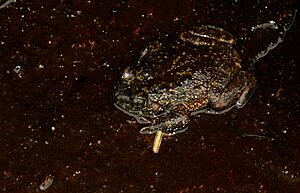Kirtisinghe's rock frog facts for kids
Quick facts for kids Kirtisinghe's rock frog |
|
|---|---|
 |
|
| Conservation status | |
| Scientific classification |
The Nannophrys marmorata, also known as Kirtisinghe's rock frog or marbled streamlined frog, is a special type of frog. It lives only in Sri Lanka, meaning it is endemic to that country.
This frog used to be part of a big frog family called Ranidae. But scientists studied its DNA and found it actually belongs to a different family, the Dicroglossidae. Kirtisinghe's rock frog naturally lives in warm, wet forests, cool mountain forests, and near rivers and streams. Sadly, its home is shrinking, which puts it in danger.
About Kirtisinghe's Rock Frog
Kirtisinghe's rock frog is a small animal. It has a wide, short head and a rounded nose. You can see its eardrums right behind its big, noticeable eyes. These eardrums are about half the size of its eyes.
The frog's body is strong and its legs are not too long. Its back is brown with darker stripes or spots. Its belly is a light grey color. The legs have dark brown bands across them. Kirtisinghe's rock frog grows to be about 2.5 cm (1 in) long. That's about the size of your thumb!
Where This Frog Lives
Kirtisinghe's rock frog lives only in the central part of Sri Lanka. You can find it in a place called the Knuckles Mountain Range. It lives at heights between 200 and 1,200 metres (660 and 3,940 ft) above sea level.
This frog is a semi-aquatic species. This means it spends time both in water and on land. It likes to live in and next to fast-flowing mountain streams in forested areas. You might find it hiding under large rocks, in cracks in the rocks, or on wet surfaces. Even the baby frogs, called tadpoles, live on rocks. They are found in the wet areas near the rushing water.
Why This Frog is in Danger
The number of Kirtisinghe's rock frogs seems to be going down. Because of this, it is listed as "Critically endangered" on the IUCN Red List of Threatened Species. This is a list of animals and plants that are at high risk of disappearing forever.
One reason it's in danger is that it lives in several small, separate groups. The total area where it lives is only about 100 square kilometres (39 sq mi). Its home is being lost because of things like animals grazing (eating plants) and too much tourism. Also, the streams where it lives might be getting polluted. This pollution can come from chemicals used on nearby tea and cardamom farms.


